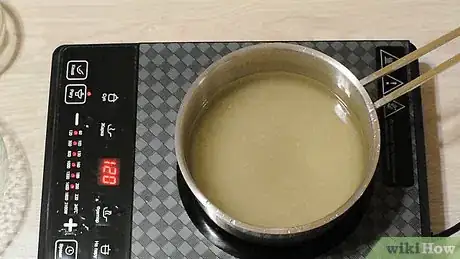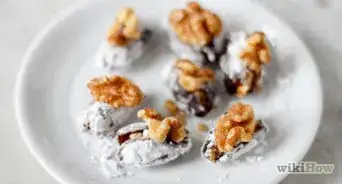This article was co-authored by wikiHow Staff. Our trained team of editors and researchers validate articles for accuracy and comprehensiveness. wikiHow's Content Management Team carefully monitors the work from our editorial staff to ensure that each article is backed by trusted research and meets our high quality standards.
There are 8 references cited in this article, which can be found at the bottom of the page.
The wikiHow Video Team also followed the article's instructions and verified that they work.
This article has been viewed 193,521 times.
Learn more...
The buttery pastry of kunafa is typically prepared and eaten during Ramadan. The dessert has Middle Eastern and Greek origins and often features a creamy filled center and a lemon simple syrup glaze on top. While you can purchase this pastry in most bakeries during Ramadan, it is also a simple pastry to make and enjoy year-round. With just some shredded kataifi (phyllo) dough and a filling of your choice, you will be able to recreate this flavorful pastry at home.[1]
Ingredients
- 1 ½ cups (345 g) of granulated sugar
- 1 cup (240 mL) of water
- Juice from half of a lemon
- 1 tablespoon (15 mL) of corn syrup (optional)
- 1⁄2 teaspoon (2.5 mL) of rose water or 1⁄2 teaspoon (2.5 mL) of vanilla extract (optional)
Dough and Filling
- 1 lb (454 g) of kataifi dough—shredded phyllo dough
- 1 cup (225 g) of melted butter
- ¼ cup (40 g) of blanched almonds
- 1 lb (453 g) of cream, ricotta cheese, or mozzarella cheese
- 2 cups (240 g) of chopped walnuts or pistachios (optional)
- 2 ½ tbsp (22.5 g) granulated sugar or brown sugar (optional)
- ½ cup (75 g) of golden raisins (optional)
- 2 tsp (4.6 g) of ground cinnamon (optional)
Makes 10-12 servings of kunafa.
Steps
Creating the Lemon Simple Syrup Topping
-
1Bring the sugar, water, and lemon juice to a boil in a saucepan. Start by adding 1 cup (240 mL) of water to create a liquid base in the pan. Then mix in 1 ½ cups (345 g) of granulated sugar and the juice from half of a lemon. Do this over a medium-high heat, and continuously stir the mixture to keep the sugar from burning.[2]
-
2Lower to a medium-low heat and allow the mixture to simmer for 3-5 minutes. Keep stirring the mixture as it simmers. When it is ready, remove the pan from the heat. The liquid will look clear and the granules of sugar will be completely dissolved.[3]
- Continue to simmer the mixture if the granules are not dissolved after 5 minutes. As long as you stir, the liquid will not burn and the taste won’t be altered. However, the longer you simmer the mixture, the thicker the consistency will be after it cools.
Advertisement -
3Transfer the syrup into a sealable glass bowl and store it in the refrigerator. Let the syrup rest 1-2 minutes in the pan, and then pour it into a glass bowl that has a lid and put it in the refrigerator. While in the refrigerator, the syrup will thicken considerably as it cools off. Leave the syrup in the refrigerator until you are ready to use it.[4]
- Add additional flavorings to the lemon-simple syrup before it cools completely while resting in the pan. Consider adding 1⁄2 teaspoon (2.5 mL) of rose water or 1⁄2 teaspoon (2.5 mL) of vanilla extract to reduce the tangy taste of the lemon. Leave the syrup as is if you want a stronger, lemony flavor.[5]
- If you are not planning to make the kunafa dough the same day as the simple syrup, add 1 tablespoon (15 mL) of corn syrup before placing it in the refrigerator to maintain the smoothness of the simple syrup. The syrup will keep in the refrigerator up to 1 week.
Assembling the Pastry
-
1Preheat your oven to 350 °F (177 °C) to save yourself waiting time later. Make sure the racks in the oven are clear of any baking pans or trays. Place the oven rack along the center rung in the oven, so your kunafa does not cook to close to the top or bottom of the oven.[6]
-
2Grease a cake pan with melted butter to keep the dough from sticking. The cake pan can be whatever shape you want—square, circle, or rectangle—but aim to have the cake pan at least 2 in (5.1 cm) deep. This will give your dough enough room to rise. You can also use a deep-dish pizza pan if you do not have a cake pan that is deep enough.[7]
- For a traditional shape, use a standard round cake pan that is 12 in (30 cm) in diameter and 2 in (5.1 cm) deep.
- Instead of butter, you can use olive oil to grease the pan.[8]
-
3Mix 1 lb (454 g) of kataifi dough and 1 cup (225 g) of melted butter in a bowl. Use your fingers to break up the clumped strands of kataifi dough before adding the melted butter. Then thoroughly toss the pastry dough strands with your fingers until they are evenly coated with the melted butter.[9]
- Kataifi dough is thin strands of phyllo pastry dough, and can be purchased in Middle Eastern or Greek markets, or in the world food section of your local grocery store.[10]
-
4Decorate the bottom of the greased cake pan with blanched almonds. Arrange the almonds into the shape of a flower or starburst for a traditional look, or have fun creating a design unique to you. Lay the almonds to look like a spiral or shape the almonds into a letter to represent someone’s name.[11]
- Aim to use no more than ¼ cup (40 g) of blanched almonds. This way, the flavors will remain balanced throughout the dessert and you will not just be eating a mouthful of almonds.
-
5Press half of the kataifi dough into the decorated pan. Use your fingertips to gently spread the dough out until it is even. Do not plop the dough or press it against the bottom of the pan too firmly; otherwise, you may disturb the almond design or overwork the dough.[12]
- You do not have to have an exact measurement of dough in the bottom of the pan. Just use your best judgment to divide the dough in half.
-
6Add a layer of creamy pudding, ricotta, or mozzarella for the filling. The ingredients used in the creamy filling of the kunafa vary, so choose a filling texture or taste that appeals to you the most. Experiment with the amount that you use, but avoid using more than 1 lb (453 g) of the filling.
- To make the classic creamy pudding filling, boil 1⁄2 cup (120 mL) of milk or cream. Then add 1/8 tsp (0.29 g) of sugar and cornstarch, and stir the mixture until it thickens.[13]
- Instead of a creamy filling, opt for a dairy-free, crunchy filling. Mix together 2 cups (240 g) of chopped walnuts or pistachios, 2 ½ tbsp (22.5 g) granulated sugar or brown sugar, ½ cup (75 g) of golden raisins, and 2 tsp (4.6 g) of ground cinnamon. Then evenly layer the mixture onto the dough.[14]
-
7Take the remaining dough and press it evenly over the filling. Make the top layer of dough as even as possible so the pastry cooks evenly. Gently, spread it out with your fingers until it covers the inside of the pan and none of the filling is showing. Be careful not to press so hard that you cause the filling to overflow.
Baking and Glazing the Kunafa
-
1Bake the pastry in the oven at 350 °F (177 °C) for 30-45 minutes. Check on the kunafa to see if the crust has a golden coloring that resembles the color of cornbread. The golden color indicates that it is done cooking. [15]
- If the kunafa does not have any golden coloring, let it continue baking and check on it every 1-2 minutes.
-
2Pour the lemon simple syrup on the kunafa and let it rest for 10 minutes. The warm pastry will melt the syrup into a thin glaze. Allow the kunafa to cool off before removing it from the pan. This will also give the syrup a chance to soak into the pastry.[16]
- Use a spatula to help spread the syrup around the surface of the kunafa. Since the syrup was chilled in the refrigerator, it may be difficult to spread at first.
-
3Rest a serving plate on the top of the pan and carefully flip the pan over. Since you greased the pan, the kunafa will slide out and rest on the dish. If you are afraid that the kunafa won’t fall out of the pan, run a thin spatula around the sides of the kunafa before attempting to flip it.[17]
- Dairy fillings that have not rested after baking in the oven may have to be cut and served in the pan to keep the filling from running out.[18]
-
4Add additional garnishes that will complement your kunafa before serving. Pick ingredients you may have used inside of your kunafa to garnish it. For a traditional taste, leave the kunafa as is, and enjoy!
- Some common garnishes are powdered sugar, cinnamon, or pistachios.[19]
- Put leftovers in a sealable container, and store them in the refrigerator for up to a week. You can eat the leftovers cold, or reheat them in the oven to maintain the crunch of the crust. To do this, place the leftovers on a pan covered in foil and bake them 10-15 minutes at 350 °F (177 °C).[20]
Community Q&A
-
QuestionWhat kind of cheese can I use?
 Rebecca MclarenCommunity AnswerYou can use any kind of cheese, but one of the more popular cheeses used in kunafa is mozzarella.
Rebecca MclarenCommunity AnswerYou can use any kind of cheese, but one of the more popular cheeses used in kunafa is mozzarella. -
QuestionCan I make phyllo at home?
 Community AnswerYes, you can make it at home.
Community AnswerYes, you can make it at home. -
QuestionHow do I store my kunafa?
 Community AnswerYou can cover it and place it in the fridge to store it. You can also freeze it if you would like to store it long-term.
Community AnswerYou can cover it and place it in the fridge to store it. You can also freeze it if you would like to store it long-term.
Things You’ll Need
- Baking pan in a shape of your choosing, or an aluminum disposable baking pan
- Serving tray of equal size to the pan you choose
- Skillet pan
- 2 bowls
- Heat-resistant spoon
- Measuring cups and measuring spoons
References
- ↑ http://www.maggwire.com/kunafa-recipe/
- ↑ https://www.geniuskitchen.com/recipe/kunafa-the-traditionally-desert-421973#activity-feed
- ↑ https://whatscookingamerica.net/Sauces_Condiments/SimpleSyrup.htm
- ↑ https://whatscookingamerica.net/Sauces_Condiments/SimpleSyrup.htm
- ↑ https://www.vahrehvah.com/kunafa
- ↑ http://www.maggwire.com/kunafa-recipe/
- ↑ https://www.geniuskitchen.com/recipe/kunafa-the-traditionally-desert-421973#activity-feed
- ↑ http://www.maggwire.com/kunafa-recipe/
- ↑ http://www.maggwire.com/kunafa-recipe/
- ↑ https://www.thedailymeal.com/cook/what-kunafa
- ↑ https://www.geniuskitchen.com/recipe/kunafa-the-traditionally-desert-421973#activity-feed
- ↑ https://www.geniuskitchen.com/recipe/kunafa-the-traditionally-desert-421973#activity-feed
- ↑ https://cleobuttera.com/middle-eastern/classic-cream-filled-konafa/
- ↑ https://www.geniuskitchen.com/recipe/kunafa-the-traditionally-desert-421973#activity-feed
- ↑ http://www.maggwire.com/kunafa-recipe/
- ↑ https://cleobuttera.com/middle-eastern/mozzarella-cheese-kunafa/
- ↑ http://www.maggwire.com/kunafa-recipe/
- ↑ https://www.geniuskitchen.com/recipe/kunafa-the-traditionally-desert-421973#activity-feed
- ↑ https://www.vahrehvah.com/kunafa
- ↑ http://hadiaslebanesecuisine.com/newsite/recipe-items/nabulsi-knafehkunafa-knafeh-nabulsieh/
About This Article
To make lemon kunafa, start by making the lemon simple syrup for the topping and store it in the refrigerator while you assemble the pastry. Next, mix the kataifi dough and melted butter together and press half of the dough into the bottom of a baking pan. Then, add a layer of creamy pudding, ricotta, or mozzarella for the filling and press the other half of the dough on top. Finally, bake the pastry at 350 °F for 30-45 minutes before drizzling the lemon simple syrup over it! To learn more about making lemon simple syrup, read on!




-Final.webp)














































